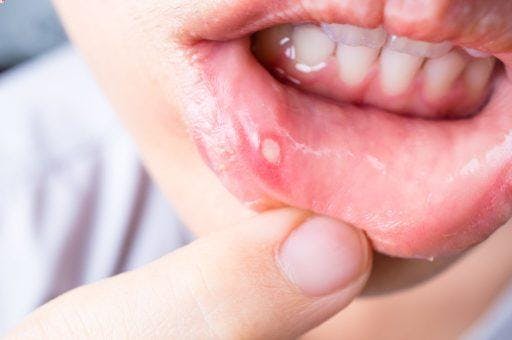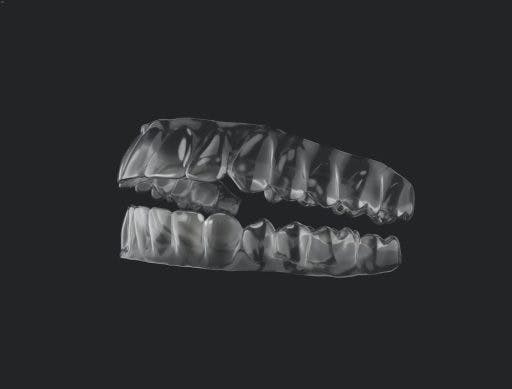From time to time, you’ve probably experienced the pain of mouth ulcers. Those pesky little sores that pop up in your mouth all of a sudden.
For the lowdown on what exactly these ulcerations are, the causes, and how you can prevent them, we have you covered. Read on to get the answers to these pressing questions and more.
What are mouth ulcers?

Surely, you’ve bitten the inside lining of your mouth at least once while eating or speaking. And that likely led to a small, yellowish or greyish round sore with a swollen edge forming at the impact site. Hello, mouth ulcer!
Such ulcerations “usually occur on the inside of the lips and cheeks and underneath and on the edge of the tongue,” warns the Pharmaceutical Society of Australia (PSA). Sometimes, they can also form on the roof of the mouth or the gums.
Are all mouth ulcers painful? In most cases, you won’t know you have an ulcer unless you feel a sting, irritation, and – yes – pain. Severe cases might even make drinking, chewing, and swallowing difficult. However, you can expect the ache to ease as the mouth sore heals. If the ulcer persists, schedule an appointment with your dentist immediately.
Are mouth sores the same as cold sores?
The National Institute of Dental and Craniofacial Research differentiates the two. Cold sores, otherwise known as fever blisters, are patches of “painful fluid-filled sores that form on the outside of the mouth around the lips.” They are contagious, which means you can spread them through kissing or sharing utensils, whereas ulcers that form inside the mouth are not.
What causes mouth ulcers?

The International Journal of Dentistry says numerous factors can lead to an ulcer. Besides the biting scenario mentioned above, here are other causes:
- Burns from hot foods and beverages
- Spicy, salty, and acidic foods
- A diet low in certain vitamins and minerals, like B12, iron, and folic acid
- Teeth with sharp edges
- Intense toothbrushing
- Irritation from toothpaste, mouthwash, and other oral products
- Improper dental fillings
- Ill-fitting dentures
- Dry mouth
- Quitting smoking
- Immense stress
- Lack of sleep
- Weak immune system
- Hormonal changes during menstruation
- Certain medical conditions, including infections and inflammatory bowel disease
- Some medicines and health treatments
- Infection from certain viruses, bacteria, or fungi
Can orthodontics lead to mouth sores?
Unfortunately, yes. You have to deal with ulcers when you’re getting your teeth straightened. Think of them as a small price to pay for your dream smile.
The American Dental Association emphasises that “irritation from a loose orthodontic wire” can cause mouth sores. This is most common at the beginning of treatment as objects with sharp or rough edges rub the soft tissues and irritate the area. This scenario is less likely once your mouth gets used to wearing the appliance.
A 2020 study in the Journal of Family Medicine and Primary Care further explains: “Ulcerations can happen due to brackets, bands, arch wires, and long unsupported stretches of wire resting against the lips.”
To support this claim, researchers surveyed over a hundred patients undergoing orthodontic treatment. They found that 63% had mouth ulcers. Additionally, 55.3% of the treating dentists involved in the research confirmed that orthodontic appliances caused such oral conditions.
Can aligners also cause oral ulcers?

You don’t have to deal with mouth ulcers during your alignment therapy.
A Medical Principles and Practice study compared the oral impacts experienced by patients treated with removable and fixed orthodontic appliances. It found that clear aligner therapy is “more tolerable as it satisfies patient needs over food consumption and absence of mucosal ulcerations.”
So, you’re less likely to get ulcers with removable orthodontics, especially because you won’t find the brackets, bands, and archwires mentioned above in aligners like ClearCorrect. And compared to traditional braces, these customised orthodontics are more comfortable. Made with a revolutionary tri-layer ClearQuartz material, these aligners exert gentle force to move teeth into their proper positions. Plus, their high, flat trimline makes them look natural.
Take this smile assessment to find out if you’re a candidate for invisible aligners.
How to prevent mouth ulcers

You can also take proactive steps to avoid getting oral ulcerations. The PSA suggests the following:
- Maintain good oral health by brushing and flossing regularly.
- Use a soft-bristled toothbrush.
- Don’t use mouthwash with alcohol.
- Clean dental appliances thoroughly.
- Consume a healthy diet of vegetables, fruits, whole grains, and proteins.
- Drink enough fluids every day.
- Take vitamin and mineral supplements if advised by your doctor.
- Manage stress by learning relaxation techniques.
How to get rid of mouth ulcers
The American Association of Orthodontists suggests applying a small amount of topical anaesthetic on the ulcerated surface using a cotton swab; repeat as needed. Optionally, you can take medicines to reduce the pain. When wearing fixed orthodontic appliances like braces, you can use dental wax to minimise friction.
The great news? The PSA reveals: “Most mouth ulcers are not harmful and heal on their own in seven to 14 days.” The tissues in your mouth will also eventually adapt and stop developing sores.
When to seek help for your mouth ulcers
If the ulcerations don’t heal within two weeks, it’s best to consult your dentist. Other instances where you should seek the advice of a specialist? If your mouth ulcers frequently recur or are painful to the point of debilitation.
Are you taking special medication or dealing with a condition? Certain illnesses and disorders, like autoimmune disorders, gastrointestinal problems, or viral infections can also cause mouth ulcers. People with weakened immune systems are also more prone to these sores.
However, there’s no reason to fear mouth ulcers throughout your orthodontic treatment. The discomforts will be short-lived – especially if you choose to go with ClearCorrect. Go ahead and claim that winning smile!
References:
Alajmi, S., Shaban, A., & Al-Azemi, R. (2019). Comparison of Short-Term Oral Impacts Experienced by Patients Treated with Invisalign or Conventional Fixed Orthodontic Appliances. Medical Principles and Practice, 29(4), 382–388.
AlDahash, F., AlShamali, D., Al-Bander, W., Bakhsh, R., AlMadhi, W., & AlSenani, S. (2020). Oral mucosal ulceration during orthodontic treatment: The perception of patients and knowledge and attitude of the orthodontic practitioners. Journal of Family Medicine and Primary Care.
Baum, A. (2023a). Handling orthodontic issues at home. American Association of Orthodontists.
Department of Health & Human Services. (n.d.-d). Mouth ulcers. Better Health Channel.
Fever blisters & canker sores. (n.d.-b). National Institute of Dental and Craniofacial Research.
Mainali, A. (2013). Occurrence of Oral Ulcerations in Patients undergoing Orthodontic Treatment: A Comparative study. Orthodontic Journal of Nepal, 3(2), 32–35.
Minhas, S., Sajjad, A., Kashif, M., Taj, F., Waddani, H. A., & Khurshid, Z. (2019). Oral Ulcers Presentation in Systemic Diseases: an update. Open Access Macedonian Journal of Medical Sciences, 7(19), 3341–3347.
Mortazavi, H., Safi, Y., Baharvand, M., & Rahmani, S. (2016). Diagnostic features of common oral ulcerative lesions: an updated decision tree. International Journal of Dentistry, 2016, 1–14.
Mouth Sores. (n.d.). American Dental Association.
Mouth ulcers. (2016, July). Pharmaceutical Society of Australia.
Mouth ulcers. (n.d.). Oral Health Foundation.



